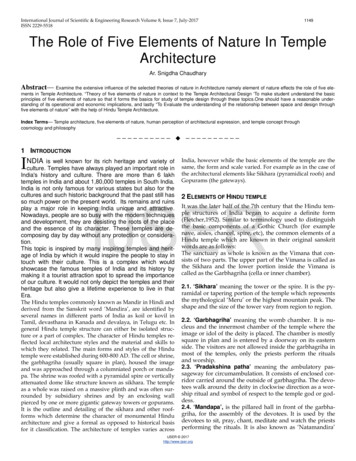
Transcription
International Journal of Scientific & Engineering Research Volume 8, Issue 7, July-2017ISSN 2229-55181149The Role of Five Elements of Nature In TempleArchitectureAr. Snigdha ChaudharyAbstract— Examine the extensive influence of the selected theories of nature in Architecture namely element of nature effects the role of five elements in Temple Architecture. “Theory of five elements of nature in context to the Temple Architectural Design ‘To make student understand the basicprinciples of five elements of nature so that it forms the basics for study of temple design through these topics.One should have a reasonable understanding of its operational and economic implications, and lastly “To Evaluate the understanding of the relationship between space and design throughfive elements of nature’’ with the help of Hindu Temple Architecture.Index Terms— Temple architecture, five elements of nature, human perception of architectural expression, and temple concept throughcosmology and philosophy—————————— ——————————1 INTRODUCTIONINDIAis well known for its rich heritage and variety ofculture. Temples have always played an important role inIndia's history and culture. There are more than 6 lakhtemples in India and about 1,80,000 temples in South India.India is not only famous for various states but also for thecultures and such historic background that the past still hasso much power on the present world. Its remains and ruinsplay a major role in keeping India unique and attractive.Nowadays, people are so busy with the modern techniquesand development, they are desisting the roots of the placeand the essence of its character. These temples are decomposing day by day without any protection or consideration.This topic is inspired by many inspiring temples and heritage of India by which it would inspire the people to stay intouch with their culture. This is a complex which wouldshowcase the famous temples of India and its history bymaking it a tourist attraction spot to spread the importanceof our culture. It would not only depict the temples and theirheritage but also give a lifetime experience to live in thatEra.India, however while the basic elements of the temple are thesame, the form and scale varied. For example as in the case ofthe architectural elements like Sikhara (pyramidical roofs) andGopurams (the gateways).IJSERThe Hindu temples commonly known as Mandir in Hindi andderived from the Sanskrit word ‘Mandira’, are identified byseveral names in different parts of India as koil or kovil inTamil, devasthana in Kanada and devalaya, in Telugu etc. Ingeneral Hindu temple structure can either be isolated structure or a part of complex. The character of Hindu temples reflected local architecture styles and the material and skills towhich they related. The main forms and styles of the Hindutemple were established during 600-800 AD. The cell or shrine,the garbhagriha (usually square in plan), housed the imageand was approached through a columniated porch or mandapa. The shrine was roofed with a pyramidal spire or verticallyattenuated dome like structure known as sikhara. The templeas a whole was raised on a massive plinth and was often surrounded by subsidiary shrines and by an enclosing wallpierced by one or more gigantic gateway towers or gopurams.It is the outline and detailing of the sikhara and other roofforms which determine the character of monumental Hinduarchitecture and give a formal as opposed to historical basisfor it classification. The architecture of temples varies across2 ELEMENTS OF HINDU TEMPLEIt was the later half of the 7th century that the Hindu temple structures of India began to acquire a definite form(Fletcher,1952). Similar to terminology used to distinguishthe basic components of a Gothic Church (for examplenave, aisles, chancel, spire, etc), the common elements of aHindu temple which are known in their original sanskritwords are as follows:The sanctuary as whole is known as the Vimana that consists of two parts. The upper part of the Vimana is called asthe Sikhara and the lower portion inside the Vimana iscalled as the Garbhagriha (cella or inner chamber).2.1. ‘Sikhara’ meaning the tower or the spire. It is the pyramidal or tapering portion of the temple which representsthe mythological ‘Meru’ or the highest mountain peak. Theshape and the size of the tower vary from region to region.2.2. ‘Garbhagriha’ meaning the womb chamber. It is nucleus and the innermost chamber of the temple where theimage or idol of the deity is placed. The chamber is mostlysquare in plan and is entered by a doorway on its easternside. The visitors are not allowed inside the garbhagriha inmost of the temples, only the priests perform the ritualsand worship.2.3. ‘Pradakshina patha’ meaning the ambulatory passageway for circumambulation. It consists of enclosed corridor carried around the outside of garbhagriha. The devotees walk around the deity in clockwise direction as a worship ritual and symbol of respect to the temple god or goddess.2.4. ‘Mandapa’, is the pillared hall in front of the garbhagriha, for the assembly of the devotees. It is used by thedevotees to sit, pray, chant, meditate and watch the priestsperforming the rituals. It is also known as ‘Natamandira’IJSER 2017http://www.ijser.org
International Journal of Scientific & Engineering Research Volume 8, Issue 7, July-2017ISSN 2229-5518meaning temple hall of dancing, where in olden days ritualof music and dance was performed. In some of the earliertemples the mandapa was an isolated and separate structure from the sanctuary.2.5. ‘Antarala’ meaning the vestibule or the intermediatechamber. It unites the main sanctuary and the pillared hallof the temple.2.6. ‘Ardhamandapa’ meaning the front porch or the mainentrance of the temple leading to the mandapa.2.7. ‘Gopurams’ meaning the monumental and ornatetower at the entrance of the temple complex, speciallyfound in south India.2.8. ‘Pitha’ the plinth or the platform of the temple.2.9. ‘Toranas’ the typical gateway of the temple mostlyfound in north Indian temple and2.10. The Amalaka the fluted disc like stone placed at theapex of the sikhara.3. EVOLUTION OF ARCHITECTURAL STYLESThe distinctive architectural styles of Hindu temples haveso developed due to broad geographical, climatic, cultural,racial, historical and linguistic differences between thenorthern plains and the southern peninsula of India.Broadly based on geography, Hindu temples have beenclassified into three different orders;1. The Nagara or ‘northern’ style,2. The Dravidian or ‘southern ‘style, and3. The Vesara or hybrid style which is seen in theDeccan between the other two.There are also other distinct styles in peripheral areas suchas Bengal, Kerala and the Himalayan valleys.1150(Brown, 1942). The temples constructed in the 8th centuryhad smaller shrines and the sikhara became the crowningfeature of the temples. The addition of mandapa (the pillared hall) to the temple started during this period itself.The other distinct character of this period was the rectangular wall around the temple and addition of subsidiaryshrines at each corner. The most common examples of thisperiod are the temples at Osian Rajasthan and the cluster ofJain temples built between 8th -12th century in Gujarat andRajasthan. The temple of Teli-ka mandir, Gwalior and Vaital Deul, Bhubaneshwar were unique and inspired from theearly Buddhist architecture with rectangular plan and thebarrel vault roof of chaitya hall. These temples don’t makethe full composition of Hindu temple as they only consistof main sanctuary with neither the mandapa nor the portico. This form of architecture was abandoned by the architects in the north but was accepted in the architecture ofsouth India. A distinct architectural style developed in thetemples of Orissa (7th to 11th century). The elliptic curve ofsikhara from the earlier periods were modified as a perpendicular prismatic tower and converged near the peak.For the first time in history special attention was given tothe construction of mandapa; the roof of the mandapa wasnow pyramidical with tapering at the top and lower thanthe sikhara. The finest examples of this period are the Lingaraja temple, Bhubaneshwar, the Jaganath temple Puriand the Sun temple Konark with there sikhara height ranging from 43 m to 57 m high.IJSER4. DEVELOPMENT IN TEMPLE ARCHITECTUREAll tables and figures will be processed as images. Youneed to embed the images in the paper itself. Please don’tsend the images as separate files.4.1 NAGARA OR THE ‘NORTHERN STYLE’The characteristic temple plan of the northern India wasdeveloped in the 5th century under the rule of Hindu dynasty. These temple consisted of all the basic elements; thegarbhagriha surrounded by an ambulatory path, an outerportico with columns in front and a flat roof of stone. Thetemples constructed during this period were simple andless impressive compared to the temple constructed duringthe 10th -13th century temples.Some of the examples from this period are temples at Sanchi, Tigawa and Deogarh. The development of sikharastarted at the temple of Deogarh in Madhya ��— Author name is currently pursuing masters degree program in electricpower engineering in University, Country, PH-01123456789. E-mail: author name@mail.com Co-Author name is currently pursuing masters degree program in electricpower engineering in University, Country, PH-01123456789. E-mail: author name@mail.com(This information is optional; change it according to your need.)Figure 1.1Figure 1.1 & 1.2, Plan(Source:www.indoarch.org)Figure 1.2andviewoftheLingarajaTempleA parallel development to the Orissa temple, took place inthe central India during the 9th to 11th century. The temples of Khajuraho are famous for their conical tower madeof piles of stone with an arrangement of miniature towerscalled sikhara (Grover, 1980).Each of these temples has portico, entrance hall and thesanctum. The roofs of various sections of the temple havedistinct form.Each and every facade, wall, ceiling of these temples havecarved figures from the mythology and history. The finestexamples are the Khandriya Mahadev temple, andLakshmana temple, Khajuraho.IJSER 2017http://www.ijser.org
International Journal of Scientific & Engineering Research Volume 8, Issue 7, July-2017ISSN 2229-5518Figure 4.1Figure 2.11151Figure4.2Figure 5.1 & 5.2 Plan, Gopuram-section and view of the Minakshi Sundaresvara Temple (Source:www.indoarch.org)Figure 2.2Figure 2.1 & 2.2, Plan and view of the Kandariya Mahadeo Temple(Source:www.indoarch.org)4.2. DRAVIDIAN OR ‘SOUTHERN STYLE’Temple development in southern India started during theChalukya rule in the early 7th century. These temples wereinspired from the Buddhist architecture. The templesevolved from simple rock cut shrines to large and complicated structures. The temples in this period were largesquare building with a projecting porch and decorativepillars. The roof of the temple had small structure whichlater emerged as the sikhara. The entire temple is simplewith minimal decoration. Some of the examples from thisperiod are Lad Khan temple and Durga temple , Aihole.The rock cut structures developed during the 7th -9th century under the rule of Pallavas. The Pallava rulers lead theway of dravidian style of temple architecture and they builtthe temples at Mahabalipuram. During the Pandyas rulethe south Indian temples were added with the lofty gateways gopurams at the entrance with the basic temple composition. The gopurams made the temple visually attractiveand also provided the temples with an enclosure. Thegopurams evolved from a rectangular base with a pyramidcrowned with a barrel vaulted form. In the 11th century theChola rulers built one of the tallest temples of that time theBrihadeshvara temple, Thanjavur with a height of 60 m(Hardy 2007). In the later period the temples extended andbecame more intricate. More mandaps were included forvarious activities like dancing, assembly, eating, marriages,etc. The Dravidian style concluded in a series of extendedtemple cities or townships. The finest example of the temple township is the temple at Srirangam and Madurai withseveral concentric enclosures.4.3. THE VESARA OR THE KARNATAKA DRAVIDA ORDECCAN STYLEThe term Vesara is believed to have been derived fromthe Sanskrit word vishra meaning an area to take a longwalk. The quarters of Buddhist and Jain monks who lefturban areas to live in cave temples were called viharas.This is also in conformity with the prevalenceofarchitectureinof Vesara stylethe Deccan and central parts of South Asia vis-à-vis Nagarastyle prevalent in North India and Dravida style prevalentin South India.Accordingly, the Vesara style contain elements of bothDravida and Nagara styles. The Vesara style is also described in some texts as the 'Central Indian temple architecture style' or 'Deccan architecture'. However many historian agree that the vesara style originated in what is todayKarnataka. The trend was started by the Chalukyas of Badami (500-753AD) who built temples in a style that was essentially a mixture of the nagara and the dravida styles,further refined by the Rashtrakutas of Manyakheta (750983AD) in Ellora, Chalukyas of Kalyani (983-1195 AD)in Lakkundi, Dambal, Gadag etc. and epitomized bythe Hoysala empire (1000-1330 AD).IJSERFigure 5.1Figure 5.1, Plan of the Dravida and Nagara styles Temple(Source:www.indoarch.org)Figure 3.1Figure 3.2Figure 3.1 & 3.2 Plan and view of the Brihadeshvara Temple(Source:www.indoarch.org)5. COSMOLOGY AND HINDU TEMPLEAccording to the ancient Hindu scriptures, the temple isthe microcosm of the cosmos and the cosmic order is perceived as integral to the human body, mind and spirit; withthe human being a microcosm(Hardy, 2007). The Hindutemple structure presents the significant information aboutthe science and cosmology of the period in which theywere constructed. It is a symbolism of the outer and theinner cosmos where outer cosmos is expressed in terms ofIJSER 2017http://www.ijser.org
International Journal of Scientific & Engineering Research Volume 8, Issue 7, July-2017ISSN 2229-5518various astronomical connections between the templestructure and the motions of the sun, the moon, and theplanets, whereas the inner cosmos is represented in termsof the consciousness at the womb of the temple and variouslevels of the superstructure correspond to the levels of consciousness (Kak, 2002).The temple is a link between the physical world of manand divine world of God. And to connect them, the plan ofcosmos were graphically copied in the foundation of thetemples called as the Vastupurashamandala. The Hinduarchitecture, religious or vernacular, in the ancient timeswere based on the geometry of the Vastupurashamandala.In the words of Stella Kramrisch, “The temple is the concrete shape (mūrti) of the Essence; as such it is the residence and vesture of God. The masonry is the sheath (kośa)and body. The temple is the monument of manifestation.”The expansion may be seen either as proceeding from thecentral point of the garbhagrha in all the directions ofspace, reaching to the bindu above the finial of the templeand beyond, or as a manifestation held together by a tension between the bindu and the garbhagrha, with the axisjoining the two being the world axis (Kramrisch, 2002).1152symbolical to the recurrent cycles of time as calculated bythe movements of the moon (Gosai 2002-2008). The fourdirections lie outside the mandala which represents themeeting of the earth and the universe as well as the movement of the sun from east to west and its rotation to thenorthern and southern hemispheres. The central portion ofthe mandala is the place for the Brahma, the creator, andthe rest squares are the position of other Gods as per theirrelevance.7. VASTU AND THE FIVE ELEMENTSVastu or the Indian Feng shui is the ancient Vedic traditionof combining architecture and land development with theenergies of the five elements and the cardinal directions.Living in accordance with Vastu is said to solve most oflife’s problems. The balance or imbalance among the elements determine the conditions of one’s living space.7.1. Water-Water is associated with conception of newideas, thoughts, healing energy, restoration of health etc.Water dominates the North direction in buildings. Whenwater is in a balanced state in a building, it induces a spiritual and philosophical attitude to life. For eg-placement ofwater sources like wells, water tanks etc in the North direction gives maximum advantage.IJSER6. THE CONCEPT: - VASTUPURASHAMANDALAThe Hindu philosophy was among the first to relate thehuman figure as the basis of a system of proportion, whichwas years later demonstrated by Leonardo da Vinci and byLe Corbusier in Modular system of measurement. In Hinduphilosophy the form of the purasha (human) body wasmade to suit the abstract idea of the square, as the supremegeometric form (Groover,1980). The Vastupurashamandalais derived from three separate words each having a specificmeaning where vastu refers to physical environment, purusha refers to energy, power or cosmic being, and mandala is the diagram or chart (Rian,et al. 2007). The basic formof the Vastupurashamandala is the square and square is theimportant and ideal geometric form in Hindu philosophy,which represents the earth. All the necessary forms like thetriangle, hexagon, octogan and circle, etc can be derivedfrom the square. The four sides of the square represent thefour cardinal directions. The square also symbolizes theorder, the completeness of endless life and the perfectnessof life and death (Michell, 1988). According to Hindu beliefs, man’s everyday life is also governed by the numberfour as in four classes(varnas), four phase of life, four greateras, four head of Brahma(the creator God), the four Vedas,etc. (Exoticindiaart, 2003). Similarly, the circle representsthe universe and is considered as the perfect shape, without any beginning and end, suggesting timelessness andinfinity, a typically heavenly feature. The mandala is actually a square subdivided into smaller squares in the formof a grid with each square unit clearly marking the areas ofrespective gods. The most commonly used mandala is thesquare divided into 64 and 81 squares. Mostly the square ofthe mandala on its outer periphery are divided into 32smaller squares, in accordance to the astrological calculation called nakshatra, representing the constellations or theposition of planets through which moon passes in itsmonthlypath. The closed polygon of thirty-two squares is7.2. Air-Air represents growth and is associated withmovement, joy and happiness. Air dominates the East direction. When air is in a balanced state, it induces courageand perseverance to achieve your goals. For eg-placementof doors, windows etc should be in the East or North eastdirection to get maximum benefit7.3. Fire-Fire is the driving force behind all life processesand South is the direction of fire. When it is in a balancedstate, it induces power, confidence, fame recognition andmoney. For eg-geysers, fireplace and kitchen in theSouth/South east direction would provide maximum benefits.7.4. Earth-Earth represents stability and balance and do-minates Centre and Diagonal directions. When it is in abalanced state, it induces stability and a feeling of peaceand harmony. for eg-Since earth is connected to all fivesenses of the human body, sleeping with the head towardsthe south helps us to draw maximum positive energy fromthe cosmos.7.5. Space-Space represents expansion and enhancementand dominates the Western direction. When it is in a balanced state, it induces knowledge and awareness to understand new and creative ideas. For eg- the Brahmasthanor the central portion should be built in such a way thatlight enters its centre and it should always be kept open.Since these five elements are related to our five senses taste,smell, hear, touch and sight the aim of Vastu Shastra is toIJSER 2017http://www.ijser.org
International Journal of Scientific & Engineering Research Volume 8, Issue 7, July-2017ISSN 2229-5518enable a perfect construction and to correct the internal andexternal imbalances and ensure a peaceful and stress freelife.1153the temple Therefore the large squares of mandala were divided into thousand squares thus virtually forming a graphpaper for the architect to facilitate him to add a unit at oneside and setting back on the other.Figure 8 (Vastupurashamandala)8. ROLE OF FIVE ELEMENTS OF NATURE AND HINDUTEMPLEThe Divine reveals the glories of this universe to mankindthrough Prakriti or Nature. No one can comprehend nature. It presides over the destinies of all creatures. Continual change is the very nature of creation. It is impermanent and immutable. The Creator is the only Unchangingeternal entity amongst this changing world.The entire cosmic creation begins from the point of thePancha Bhutas or the 5 elements. They are Earth or Prithvi,Water or Jal, Fire or Agni, Air or Vayu, Ether or Akash.These five elements contain five characteristics. They touch),Roopa(sight),Rasa(taste),Gandha(smell).Thus every individual has these distinct five faculties as each of these faculties has emanated from one particular element.Akash or Ether is the first element and accounts for theemergence of the organ of hearing-the ear and isrepresented by sound. It represents the space in which everything takes placeThe second element is Vayu or air and the skin is the product of the principle represented by touch. It represents thegaseous state of matter and is responsible for the respiratory system.The third element is Agni or fire and the eye is the organrepresenting sight. It represents form without substanceand is responsible for digestion and perception.The fourth element is Jal or water and is represented by theorgan tongue which is used for the dual function of tasteand speech. It represents the liquid state of matter and isresponsible for fluid metabolism in the body. Blood, lymphand other fluids are considered as water elements.The fifth element is Prithvi or earth and the nose is the organ representing smell. It represents the solid state of matter and is responsible for the physical constitution of thebody. Bones, tissues and teeth are considered as earth elements.Earth or Akash is the most subtle element, each element inturn is used to create the next element, each less subtle thanthe next. The basest element earth can be perceived by allIJSERFigure 6 (Vastupurashamandala)The vastupurashamandala are the square grids and are ofvarious types formed from the fundamental shape, thesquare. The smaller squares in the grid are called as the onepada and they may vary from 1, 4, 9, 16, 25, and so on 1024and follows a geometric progression series of 1, 2, 3, 4, 5,U,32 with the common factor 2. There can be even numbers ofpada and odd numbers of pada in a mandala and are calledas yugma mandala and ayugma mandala respectively. Vastupurushamandala has different names according to thenumbers of pada within the grid. The mandala having1,4,9,16,25 and 36 numbers of pada within the grid areknown as sakala mandala, pechaka mandala, pitah mandala, mahapitah mandala, manduka chandita mandala andparamasayika mandala, respectively.Figure 7 – The various types of Vastupurashamandala(1, 4, 9, 16,64and 81) (Source: Rian, et al 2007)The Vastupurashamandala, having all the geometrical, astronomical and human properties was the basis of the groundfloor plan for all Hindu temples. The basic shape acquiredby the temple plan is the outer most ring of square of themandala forms the thickness of walls of main shrine. Thecentral 4 squares acquire the place of the main deity andthe inner ring of 12 squares form the walls of the garbhagriha and the next 16 to 28 forms the pradkshina patha. Thesesimple divisions of square with many permutations andcombinations became the base for the complex structures ofthe temple; in the form of orthogonal and stellate plans ofIJSER 2017http://www.ijser.org
International Journal of Scientific & Engineering Research Volume 8, Issue 7, July-2017ISSN 2229-5518five senses sight, hearing, smell, taste and touch. The nexthigher element water has no smell but can be heard, felt,seen and tasted. Next comes fire which can be heard, feltand seen. After that comes air which can be heard and felt.Last comes Akash which can only be heard.1154the tongue and are conveyed to the corresponding braincentre through the sensory nerves.9.3. Shapes and forms are associated with fire element.Light energy in the visible spectrum is received and recognized by the eye. Thus this element represents that entitywhich provides definition to any material object. The perception of rupa or form is associated with this element.9.4. Touch is associated with air element.Here it represents electromagnetic energy whose distinguishing feature is movement. When energy impinges onthe skin as heat or electrical sensation, the impulses are carried through the sensory nerves to the corresponding centre in the brain. Touch is essential for this knowledge andthe quality is attributed to vayu or energy in motion.9.5. Sound with ether elementThere is no sound propagation through a vacuum. Soundrequires a medium. Speech is conveyed to the ears throughair. Vibration of successive particles of a medium is propagated as a sound wave. These impulses are then carried bythe auditory nerves to the relevant centre in the brainwhich interprets it as sound. Thus akash or space or etheris considered to be a conveyor of sound.IJSERFigure 8 (Pancha Bhutas or the 5 elements)9. KARMENDRIYAS AND JNANENDRIYASAll the external sense organs which enable us to interactwith the material objects of the world like the eyes, ears,nose, tongue and skin are called Jnanendriyas or organs ofcognition and the internal organs of action that facilitatesour sensory contact with the outer world like Speech andthe mouth, Grasping and the hands, Walking and the feet,Procreation and the reproductive organs, Elimination andthe Anus are called Karmendriyas.The Karmendriyas perform acts in the world and receiveknowledge while the Jnanendriyas discriminate the goodand the bad and through the mind, offer them to the Atma.Thus these organs which are connected with Prakrithi canattain the Atma only through the mind. The combined operations of all these sense organs accounts for the humanpersonality. The ten organs, the five elements and the mindconstitute the Shodasha Kalas or the Sixteen Kalas. Everyindividual has these sixteen kalas but only the Divine isconsidered to have all these sixteen kalas in full perfection.Thus the five great elements represent the universe of matter-energy. Any imbalance in these five elements createsdisharmony in the universe like natural disasters and disease in the human body. In the Bhagvad Gita, Krishna says,’’The five elements along with the mind, intellect and egosense constitute the lower nature. Know my higher naturewhich is pure consciousness’’. Just as the universe is madeup of five elements, the mind is also made up of five elements in a subtle form. Depending on which of the elements dominate, the individual experiences differentmoods and sensations.Some examples are Feeling of heaviness, total comfort or discomfortEarth element is dominant Feeling of oneness, togetherness, floating or flowing feeling- Water element is dominant.9.1. Smell is associated with Earth element. Particles of matter or the solid forms of earth impinge onthe sensitive cells within the nose, the changes arising therefrom is recognized as smell by the corresponding braincentre which receives the sensory impulses from the olfactory region of the nose through the nerves.Feeling of wanting to keep moving, keep runningaway-Air element is dominant. Feeling of passion, fired by ambition-Fire elementis dominant. Feeling expansive and light-Space element is dominant.9.2. Taste is associated with water elementThe liquid forms of matter is characterised by fluidity. Thesense of taste is imparted by the solution of any substanceon the tongue. The changes are induced in the taste buds ofTo create a balancing effect of these five elements on thebody and mind, Yoga, pranayama etc are the techniquesgenerally adopted by men. Thus, it can be said that theseIJSER 2017http://www.ijser.org
International Journal of Scientific & Engineering Research Volume 8, Issue 7, July-2017ISSN 2229-5518five elements are derivations and expressions of a UnifyingCreative Principle which is unmanifested and one. Theyhave to be understood both in a material sense and a subtlesense. One has to delve deep and extract the inner meaningwithin each one. By Earth, it is not merely the physical terrain or thehuman body but the strength of mind, steadfastness, determination and uninterrupted advancement towards the goal.By water, it implies the cohesive reality whichflows into and holds all beings together and linkseach other to the Ultimate Reality.By fire it does not only mean the Universal energythat radiates heat and light but the inner fire thatremoves the cloak of ignorance and destroys allour doubts and allows the Truth to shine despiteall obstacles.By air, it not only implies the rarified force that exists in the universe but the energy that allows digestion, removes wastes and ensures circulation inthe human body. It regulates thoughts in our mindthrough steady breathing.115511. THE FIVE ELEMENTS AND SEVEN CHAKRASThe five elements from which all creation is manifest areaccessible through ‘Chakras’ located in the spinal area. TheChakras are energy centres in the astral body corresponding to five locations in the spinal region and two in the areaof the brain. Each chakra is endowed with the capacity toawaken certain powerful features. Muladhara chakra or Root Chakra-it representsstability and support. It indic
architecture and give a formal as opposed to historical basis for it classification. The architecture of temples varies across India, however while the basic elements of the temple are the same, the form and scale varied. For example as in the case of the architectural elements like Sik










